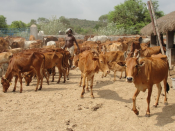
Goraksha 100% Organic Hand Pounded Rice And Kanji Powder
Goraksha Organic hand-pounded rice is made from rice grown in the Goshala without using fertilizers, chemicals, and pesticides. Only cow dung, cow urine, and other organic inputs have been used to grow the rice. The rice has been hand-pounded in order to retain all the nutrients.
Traditional varieties of rice like Mapillai samba (Red Rice), Arcot Kichili samba, and Ponni are grown in our Goshala using natural farming techniques.
The traditional varieties of rice are very tasty and have special properties. Maplillai samba, for example, is very good for diabetics. The Mapillai Samba Kanji is very tasty and can be had hot, with milk and jaggery, or cold, with buttermilk.
Earlier (Thousands of years), everyone used to eat brown rice until the invention of processing machine for white rice. People started using white rice because of its color, can be stored for a longer time than brown rice, and moreover, it takes less time to cook. Though white rice is popular, it has its own disadvantages.
Brown hand pounded rice
Brown rice is rice which is hulled (the covering husk is removed) leaving the outer layer of the bran on the grain. Brown rice contains all the edible parts of rice. The greatness of hand-pounded rice lies in its retention of bran.
Brown rice is basically unmilled or partially milled or non-polished rice. It is produced by hand pounding using a mortar and pestle or stone grinder. All types of rice are originally brown rice before they are processed into white rice. The removal of only the outermost layer (husk) of rice grains produces brown rice. When the next layers underneath the husk (the bran and the germ) are removed, the remaining starchy endosperm produces the white rice. This process strips out several of the nutrients, dietary minerals, and almost all of the rice fiber.
Brown rice is a kind of whole grain. It bears a mild nutty flavor. Brown rice is a complex carbohydrate that provides 15 essential nutrients, including B-vitamins, niacin, and potassium. In the olden days, paddy used to be hand pounded and winnowed to remove the husk and consumed as such.
Polishing removes the layer that is filled with health-supportive, essential fats that make rice highly susceptible to oxidation. Though this extends the shelf life of the product, the resulting white rice is simply a refined starch that is largely deprived of its original nutrients. But brown rice retains all the nutrients that nature bestowed it with.
Nutritional Profile of Brown Rice
Caution
Brown rice is not seen to have any negative effect on the body, including any allergic effect. It does not contain any significant amount of oxalates and purines. The inorganic brown rice contains traces of arsenic. Though low doses of arsenic are not seen to cause any serious diseases, its heavy intake can make one more susceptible to the risk of cancer.
So, always go for the organically grown brown rice, as it is free of arsenic content.
SUMMARY
Brown rice should not be treated as farmer’s food or animal feed.
It has many nutritional values. However, white rice is easy to cook and looks pleasant it is not suggested for good health. It is better to switch back to brown rice to avoid the biggest killers of present generation such as obesity, diabetes, and cancer to have healthier and longer life.
Thus, we can consider brown rice to be a complete balanced food. After discovering such amazing facts we must gear up to quit white rice and switch over to brown rice.
We have only limited quantities of rice and kanji powder and these are sold directly to interested consumers. Our products are not available in shops
Interested people may contact Radhakrishnan at 098400-41151 or send mail to purefood@goseva.net
ALL PROCEEDS ARE USED FOR GOSEVA
REFERENCES

